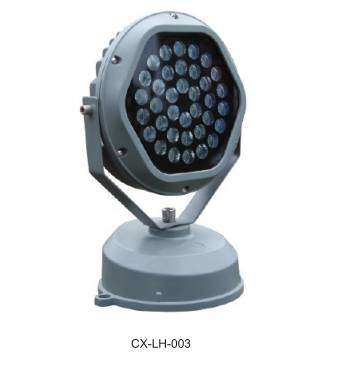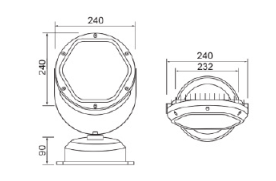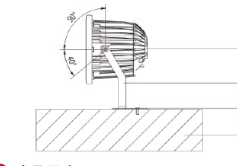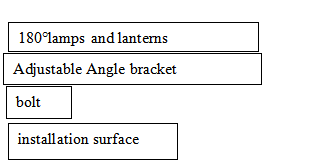The LED projector lamp is used to specify the luminance above the surrounding environment, and also called the spotlight.Usually, it can be aimed at any direction and has a structure that is not affected by climatic conditions.It is mainly used for large area operation field, building outline, stadium, overpass, monument, park and flower bed.As a result, almost all outdoor use of large areas of lighting can be seen as a projector lamp.
Description of products
1. Fashionable, modern appearance design, make lamps and lanterns also become a work of art, with the environment perfect union.
2. The main material of the luminaire is made of high strength die-casting aluminum material, and the surface anti-aging electrostatic spraying process, Self-cleaning and anti-corrosive.
3. Tempered glass cover with high strength and impact resistance.
4. The lamp can be configured white or monochromatic RGB, gorgeous lighting effects, color purity, powerful change.
5. The lamp body is made of high - die cast aluminum material, surface electrostatic spraying
6. The unique rotatable fixed bolt can be rotated 360 degrees.
7. The light source adopts 1W single RGB light source, LED combination optical arrangement, and the mixing effect is better.
8. The light can be controlled by DMX512, a powerful function of changes in lighting effects.
9.Lamp series, power can be between 18W-36W, can be used for a variety of applications.
Product show
Installation Instruction
Led Tile Slots Lamp,Led Project Lamp,Led Night Lamp,Led Mood Lamp Jiangsu chengxu Electric Group Co., Ltd , https://www.satislighting.com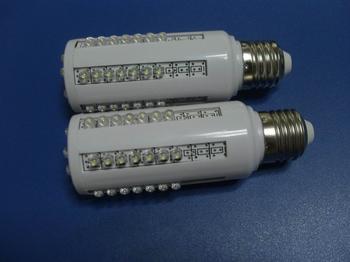 LED is a fast-developing technology and is widely used in many general lighting fields, commonly referred to as solid-state lighting. In some cases, LED has become an effective solution for architectural lighting. Compared with other lighting technologies, LEDs have superior performance and have become mainstream solutions in the current general lighting market:
LED is a fast-developing technology and is widely used in many general lighting fields, commonly referred to as solid-state lighting. In some cases, LED has become an effective solution for architectural lighting. Compared with other lighting technologies, LEDs have superior performance and have become mainstream solutions in the current general lighting market:
1. Compared with other lighting technologies, LEDs have a longer lifetime. The LED has a working life of up to 50,000 hours, while the incandescent lamp has a lifetime of only 1,000 to 2,000 hours, and a compact fluorescent lamp (CFL) has a lifetime of about 5,000 to 10,000 hours. The significant advantages in service life make LEDs ideal for commercial and industrial applications that require significant labor costs to replace lamps.
2. Energy efficiency is superior to incandescent and halogen lamps, equivalent to fluorescent lamps. In addition, the efficiency of LEDs is also increasing; the efficiency of white LEDs (WLEDs) is expected to increase by approximately 50% over the next three to four years.
3. Smaller size. The size of the LED lamp is the same as the MR16 and GU10, and the CFL cannot meet this kind of application.
4. The appropriate driver can be used to provide brightness adjustment. For applications requiring brightness adjustment, fluorescent lamps have technical limitations. Although traditional LED designs have encountered similar problems, Maxim's LED driver innovations are compatible with TRIAC dimming and trailing-edge dimming designs.
5. With strong light direction. Unlike other lighting technologies, LEDs are ideal for applications that require directional lighting, such as small-angle reflector lamps.
6. Higher efficiency at lower temperatures. Fluorescent lamp work efficiency decreases at low temperatures. In contrast, LEDs are ideal for low-temperature work environments, such as refrigerator lights.
7. Easily change the light color. This advantage makes RGBLED an ideal choice for architectural and mood lighting and can change the light color in real time according to specific requirements.
In short, LEDs have many advantages over incandescent and fluorescent lamps. Based on these advantages, designers are constantly exploring more applications for LED lighting. However, due to limited space, we will not repeat them here. This article will focus on LED lighting replacement products to replace the same size incandescent, halogen or fluorescent lamps. These LED lamps must be able to fit into existing specifications and be compatible with existing infrastructure.
LED replacement lamp Many people think that LED replacement lamp is the fastest growing market for LED lighting. The reasons for the rapid growth are simple: these lights do not require the replacement of electrical infrastructure (ie cabling, transformers, dimmers and sockets), which is a significant advantage of LED technology.
For designers, there are two main challenges in installing LED lights onto existing infrastructure:
1. Dimensions.
The replacement lamp must be able to fit into the frame of the pre-light source.
2. Electrically compatible. The replacement lamp must be able to work on the existing electrical architecture without flashing lights.
Below, we will discuss each challenge one by one.
Mounting to Existing Frames The existing frame places physical restrictions on the replacement lamp (ie, the drive plate must be small enough) and thermal limiting requirements. These factors constrain the designer's replacement of the lighting solution (for example, PAR, R, and A specifications), and the smaller the size of the application, the more difficult it is to face, such as MR16 and GU10.
Size is a key factor in constraining alternatives, and thermal limits are often more critical. LEDs only emit visible light. Unlike other technologies, they do not generate infrared radiation energy. Therefore, white LEDs are more energy efficient than incandescent or halogen lamps, and most of the heat is dissipated through the lamp's internal conductors.
Heat dissipation is a key factor that restricts the light intensity that the lamp can produce. At present, the LED technology used in lighting replacement products is difficult to reach the brightness level that the mainstream market can accept. In order to break the brightness limit, it is necessary to solve the problem of heat dissipation, which is also an essential condition for the successful commercialization of the product.
Heat dissipation also directly affects the service life of the driver board. In order to emit a higher light intensity, the lamp must operate at a relatively high temperature (+80°C to +100°C). At this temperature, the life of the driver board will limit the operation of the entire lamp, and electrolytic capacitors in particular will become a thorny issue for the design. Because electrolytic capacitors will dry quickly at high temperatures, under such conditions, the working life of such capacitors will not exceed thousands of hours, which has also become a factor restricting the service life of the entire lamp. Longer working life is a major selling point of LED lamps. For designers, electrolytic capacitors with a relatively short life time become the main design barrier.
Maxim has introduced a unique LED drive solution for 120VAC/230VAC input and 12VAC input replacement lamps. These LED drive solutions eliminate the need for electrolytic capacitors on the circuit board, extending the life of the LED lamp from typically less than 10,000 hours to 90,000 hours. Since the electrolytic capacitor is omitted, it also helps to reduce the size of the solution, so that the driver board can be installed in a small-sized retrofit lamp frame.
Compatible with Electrical Infrastructure LED retrofit lamps must work properly with existing infrastructure, including corner cut (triac and post-delay) dimmers and electronic transformers.
When connected to a 120VAC/230VAC power supply, the light can be first regulated by a Triac dimmer. Triac dimmers are designed to work well with incandescent and halogen lamps, which are purely resistive loads. However, when using an LED retrofit lamp, the LED driver is typically a non-linear, non-pure resistive load, and the input bridge rectifier typically transiently sinks large currents when the AC input voltage is at both positive and negative peaks. Triac dimmers cannot guarantee this demand for LEDs because they can neither provide the required start-up current nor provide the holding current. So that the dimmer can not start normally or normally closed during operation, but also cause the LED to flash, which is also the system unacceptable phenomenon.
As a replacement, its electrical architecture is more in line with the design of 12VAC input lighting because electronic transformers and trailing edge dimmers can be connected to the input of the lights. However, drivers for 12VAC input lamps use traditional bridge rectifiers and DC-DC converter topologies, which also produce flicker due to transformer and dimmer incompatibility.
Maxim's 120VAC/230VAC and 12VAC input lighting solutions use a single-stage conversion.
By shaping the input current, it is possible to make the lamp flicker without dimming. These solutions are compatible with bidirectional three-terminal thyristors and trailing edge dimmers and electronic transformer designs. At present, there is no MR16 solution with this feature, and few PAR, R, and A lamp solutions have this feature. In addition, our solution also has power factor correction better than 0.9, requiring very few external components. Without electrolytic capacitors, these capacitors severely restrict the operation of the driver circuit at high temperatures. Both the 120VAC/230VAC and 12VAC solutions use the MAX16834IC, which allows users to evaluate and put into mass production. These are Maxim's unique solutions, and Maxim is the only supplier that can provide this combination of advantages. 